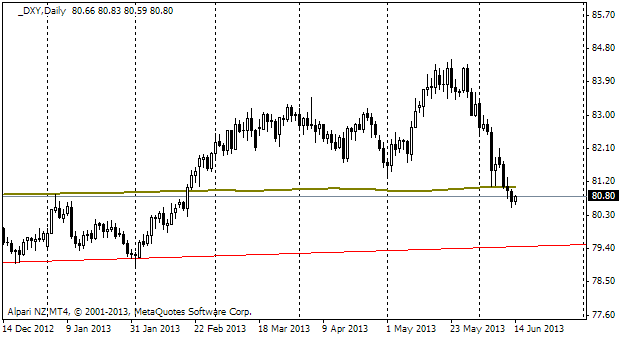EUR/usd
The dollar has been falling intensely for the recent three weeks, and the last two ones were especially active in this regard. The main reason for that disfavour towards the dollar was seen in a stream of poor news releases, which forced the markets to reconsider the date to start the stimulus rollback. We expected (and continue to expect) that weakening of the dollar will be limited as the major rivals of the US currency (EUR, JPY, GBP) are now having bigger troubles with their economies and their CBs are much farther from starting the policy toughening cycle. Anyway, in the coming weeks it is quite possible that the dollar will keep getting weaker. From the technical viewpoint, the dollar index can fall to the support at 79.40 or even to 79.0. In eurusd it can give rise to a move by another 2-2.2% up. And this will be right the target at 1.36, which we spoke about before. At the same time, yesterday we wrote that the most short-term trend in USD can be an upward one. It won't be a resumption of the global uptrend in USD, but a mere correction after the trend of the preceding three weeks. At present the market needs consolidation before another meeting of the Fed next week. The latter is not expected to cut the QE programme, but it is absolutely clear that the accompanying commentary of fomc is worth considering. If Bernanke is inclined to abandon the programme, we'll hear more specific hints than a notice that QE cannot be everlasting. Anyway, yesterday, despite the attack of the bears in the first half of the day, EURUSD closed out the day positive, at 1.3375. Now the euro is again facing light selling and has dropped down to 1.3340.

GBP/USD
Yesterday the sterling hit the 200-day MA. Formally, the day was closed even above this level (now at 1.5697), but now it is too early to celebrate the bulls' victory. It is not very often that this level is given up without a fight, when the market so methodically approaches it. It's more often that unsure hits of this levels are then followed by a reversal. Regarding important macroeconomic news for the country, there hasn't been any for two days, so the sterling has to react to outside factors.

USD/JPY
Recently the press has bristled with reproaches in regard to the results of the Japanese policy. It is emphasized that decline of the stock index and appreciation of the yen once again prove that the plan didn't work. It's hard to agree with this populism as before falling by 20% Nikkei flew up by 80% in the period from November till May. The government is also blamed for the increase in the government bond yield, but the recent move has been just a return to the levels which prevailed till the end of the last year and according to historic standards these rates are very low.

AUD/USD
The aussie was in demand all day long yesterday. At the end of the day audusd rose from 0.9480 already to 0.9630. Behind this growth there is attractiveness of purchases of the Aussie, which has dropped significantly over the last two months. Besides, stock markets performed well yesterday, and the country's labour market has proved that it is in the phase of stagnation, not of decline, as was expected by many.
